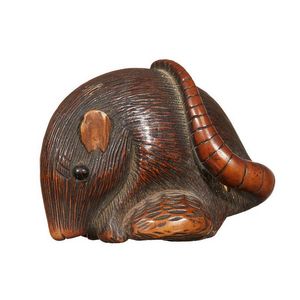Edo Period Mouse Netsuke with Horn Inlay
You must be a subscriber, and be logged in to view price and dealer details.
Subscribe Now to view actual auction price for this item
When you subscribe, you have the option of setting the currency in which to display prices to $Au, $US, $NZ or Stg.
- Edo Period, Japan - The Edo period in Japan lasted from 1603 to 1868. During this time, Japan was ruled by the Tokugawa shogunate, a military government led by the Tokugawa family. The Edo period is characterized by a period of relative peace, stability, and economic growth, as well as by the development of a distinctive culture and society.
During the Edo period, the capital of Japan was moved from Kyoto to Edo (modern-day Tokyo), and the country became increasingly isolated from the rest of the world. The shogunate implemented strict policies to maintain control, including the restriction of foreign trade and travel. However, despite this isolation, the Edo period saw significant cultural and artistic development, including the emergence of the ukiyo-e woodblock print tradition, the growth of Kabuki theater, and the flourishing of a vibrant merchant culture.
The Edo period ended with the Meiji Restoration of 1868, which saw the collapse of the shogunate and the restoration of imperial rule. - Patination / Patina - In broad terms, patination refers to the exterior surface appearance of the timber, the effect of fading caused by exposure to sunlight and air over the course of a century or more, changing the piece to a soft, mellow colour.
As patina is very difficult to replicate, it is one of the most important guides to determining the age of furniture.
Patina is also the term applied to the bloom or film found on old bronzes due to oxidisation.
This item has been included into following indexes:
Visually similar items

William Ferry (act. circa 1879-1921). A glazed slip cast earthenware mythical figure circa 1905, 20 cm high

A fine Japanese walnut Hibachi, in large proportions, finely carved & stained, with copper fitting to interior. 34 x 61 x 56 cm

A 19th century Japanese wooden netsuke of a Grazing horse, Edo period, unsigned, 5 cm high

A Fine Mask, Karau Village, Murik Lakes, Papua New Guinea, (early twentieth century), carved wood and pigments, 32.5 cm high. Provenance: Wayne Heathcote, Sydney. Acquired from above by Dr Peter Elliott, in the 1960s
